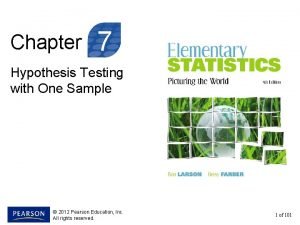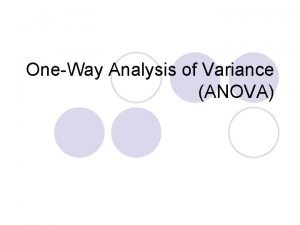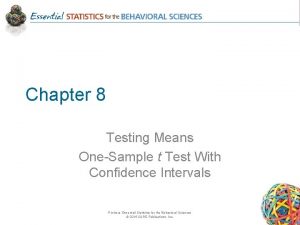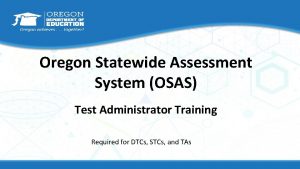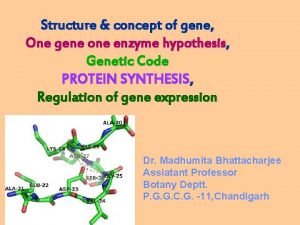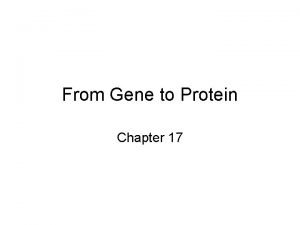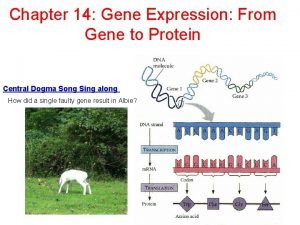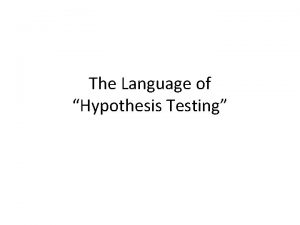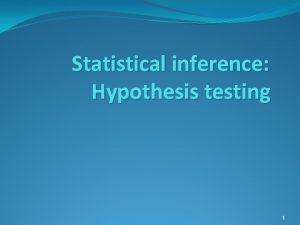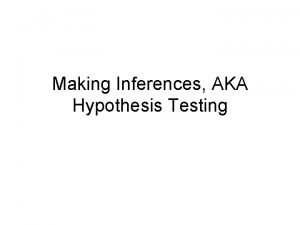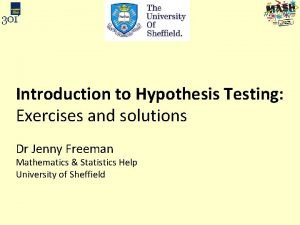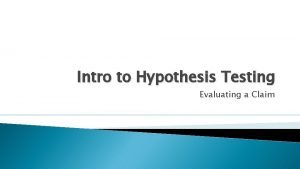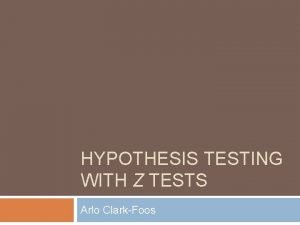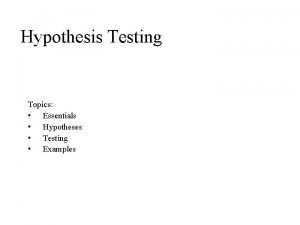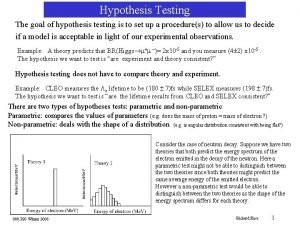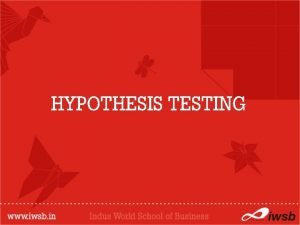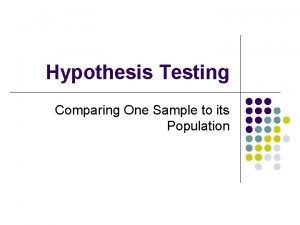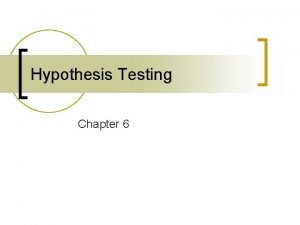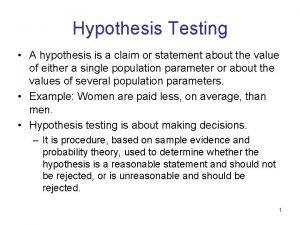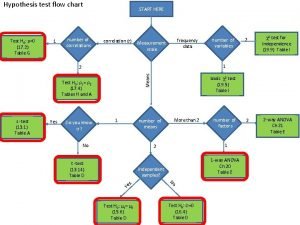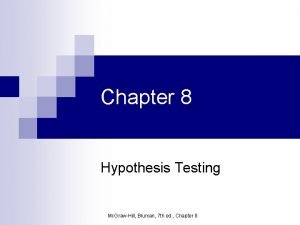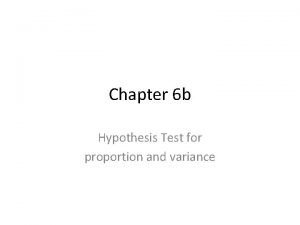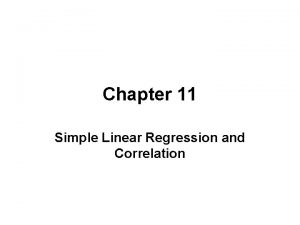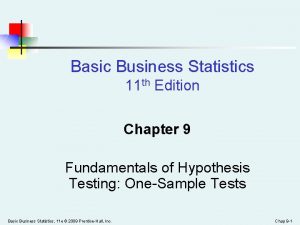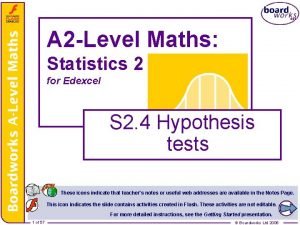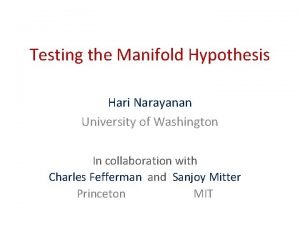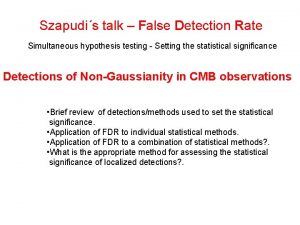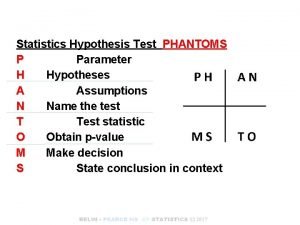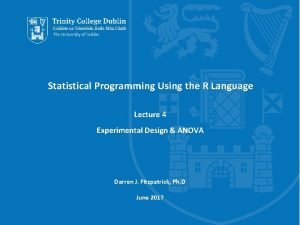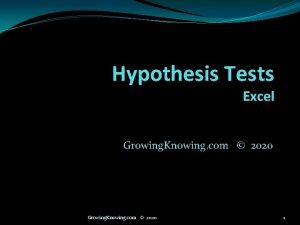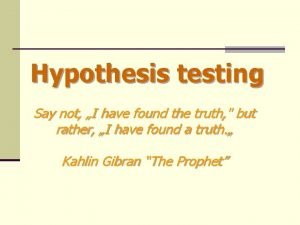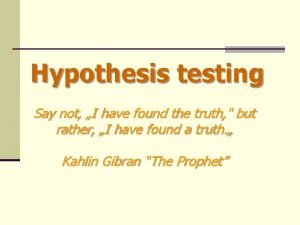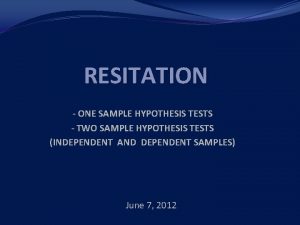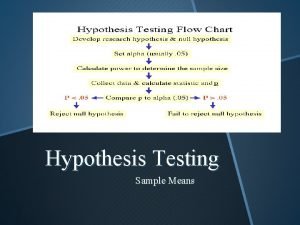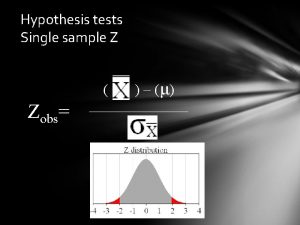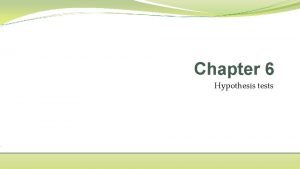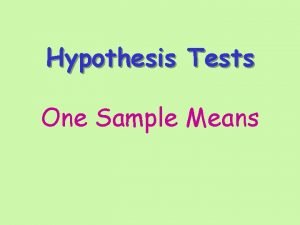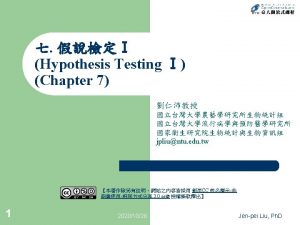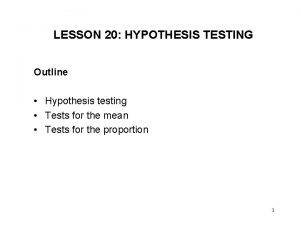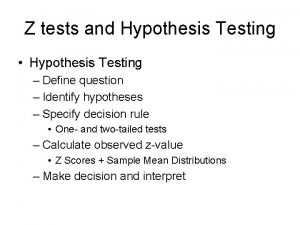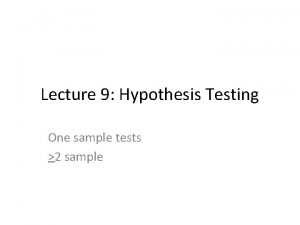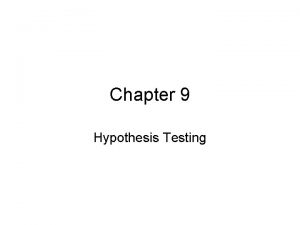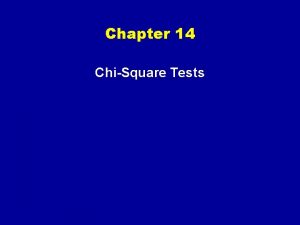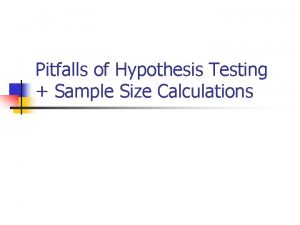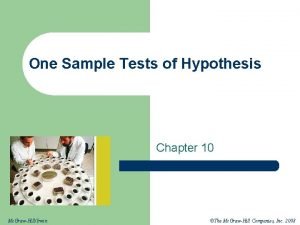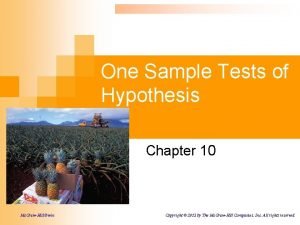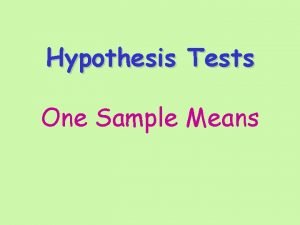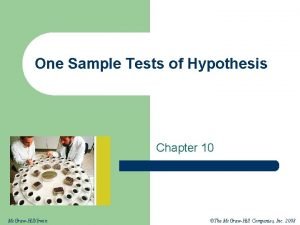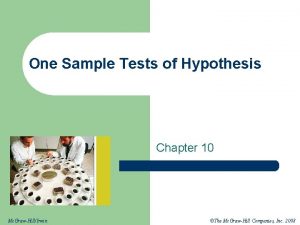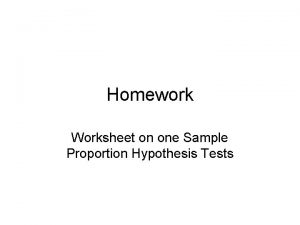Hypothesis Testing Sample One Hypothesis Tests A hypothesis



































































- Slides: 67

Hypothesis Testing Sample One

Hypothesis Tests A hypothesis test is a process that uses sample statistics to test a claim about the value of a population parameter. If a manufacturer of rechargeable batteries claims that the batteries they produce are good for an average of at least 1, 000 hours charges, a sample would be taken to test this claim. A verbal statement, or claim, about a population parameter is called a statistical hypothesis. To test the average of 1000 hours, a pair of hypotheses are stated – one that represents the claim and the other, its complement. When one of these hypotheses is false, the other must be true. Larson & Farber, Elementary Statistics: Picturing the World, 3 e 2

Types of Hypothesis “H subzero” or “H naught” A null hypothesis H 0 is a statistical hypothesis that contains a statement of equality such as , =, or . “H sub-a” An alternative hypothesis Ha is the complement of the null hypothesis. It is a statement that must be true if H 0 is false and contains a statement of inequality such as >, , or <. To write the null and alternative hypotheses, translate the claim made about the population parameter from a verbal statement to a mathematical statement. Larson & Farber, Elementary Statistics: Picturing the World, 3 e 3

Types of Hypothesis Example: Write the claim as a mathematical sentence. State the null and alternative hypotheses and identify which represents the claim. A manufacturer claims that its rechargeable batteries have an average life of at least 1, 000 hours charges. 1000 H 0: 1000 (Claim) Ha: < 1000 Condition of equality Complement of the null hypothesis Larson & Farber, Elementary Statistics: Picturing the World, 3 e 4

Types of Hypothesis Example: Write the claim as a mathematical sentence. State the null and alternative hypotheses and identify which represents the claim. London college claims that 94% of their graduates find employment within six months of graduation. p = 0. 94 H 0: p = 0. 94 (Claim) Ha: p 0. 94 Condition of equality Complement of the null hypothesis Larson & Farber, Elementary Statistics: Picturing the World, 3 e 5

Types of Errors No matter which hypothesis represents the claim, always begin the hypothesis test assuming that the null hypothesis is true. At the end of the test, one of two decisions will be made: 1. reject the null hypothesis, or 2. fail to reject the null hypothesis. A type I error occurs if the null hypothesis is rejected when it is true. A type II error occurs if the null hypothesis is not rejected when it is false. Larson & Farber, Elementary Statistics: Picturing the World, 3 e 6

Types of Errors Actual Truth of H 0 Decision H 0 is true H 0 is false Accept H 0 Correct Decision Type II Error Reject H 0 Type I Error Correct Decision Larson & Farber, Elementary Statistics: Picturing the World, 3 e 7

Types of Errors Example: London college claims that 94% of their graduates find employment within six months of graduation. What will a type I or type II error be? H 0: p = 0. 94 (Claim) Ha: p 0. 94 A type I error is rejecting the null when it is true. The population proportion is actually 0. 94, but is rejected. (We believe it is not 0. 94. ) A type II error is accepting null hypothesis when it is false. The population proportion is not 0. 94, but is accepted. (We believe it is 0. 94. ) Larson & Farber, Elementary Statistics: Picturing the World, 3 e 8

Level of Significance In a hypothesis test, the level of significance is your maximum allowable probability of making a type I error. It is denoted by , the lowercase Greek letter alpha. Hypothesis tests are based on . The probability of making a type II error is denoted by , the lowercase Greek letter beta. By setting the level of significance at a small value, you are saying that you want the probability of rejecting a true null hypothesis to be small. Commonly used levels of significance: = 0. 10 = 0. 05 = 0. 01 Larson & Farber, Elementary Statistics: Picturing the World, 3 e 9

Statistical Tests After setting the null and alternative hypotheses and specifying the level of significance, a random sample is taken from the population and sample statistics are calculated. The statistic that is compared with the parameter in the null hypothesis is called the test statistic. Population parameter μ Test statistic Standardized test statistic z (n 30) t (n < 30) z s 2 2 p 2 Larson & Farber, Elementary Statistics: Picturing the World, 3 e 10

P-values If the null hypothesis is true, a P-value (or probability value) of a hypothesis test is the probability of obtaining a sample statistic with a value as extreme or more extreme than the one determined from the sample data. The P-value of a hypothesis test depends on the nature of the test. There are three types of hypothesis tests – a left-, right-, or twotailed test. The type of test depends on the region of the sampling distribution that favors a rejection of H 0. This region is indicated by the alternative hypothesis. Larson & Farber, Elementary Statistics: Picturing the World, 3 e 11

Left-tailed Test 1. If the alternative hypothesis contains the less-than inequality symbol (<), the hypothesis test is a left-tailed test. H 0 : μ k Ha : μ < k P is the area to the left of the test statistic. z -3 -2 -1 0 1 2 3 Test statistic Larson & Farber, Elementary Statistics: Picturing the World, 3 e 12

Right-tailed Test 2. If the alternative hypothesis contains the greater-than symbol (>), the hypothesis test is a right-tailed test. H 0 : μ k Ha : μ > k P is the area to the right of the test statistic. z -3 -2 -1 0 1 2 3 Test statistic Larson & Farber, Elementary Statistics: Picturing the World, 3 e 13

Two-tailed Test 3. If the alternative hypothesis contains the not-equal-to symbol ( ), the hypothesis test is a two-tailed test. For a two-tailed test, each tail has an area of P. H 0 : μ = k Ha : μ k P is twice the area to the right of the positive test statistic. P is twice the area to the left of the negative test statistic. z -3 -2 -1 Test statistic 0 1 2 3 Test statistic Larson & Farber, Elementary Statistics: Picturing the World, 3 e 14

Identifying Types of Tests Example: For each claim, state H 0 and Ha. Then determine whether the hypothesis test is a left-tailed, right-tailed, or two-tailed test. a) A cigarette manufacturer claims that less than one-eighth of the US adult population smokes cigarettes. H 0: p 0. 125 Ha: p < 0. 125 (Claim) Left-tailed test b) A local telephone company claims that the average length of a phone call is 8 minutes. H 0: μ = 8 (Claim) Ha : μ 8 Two-tailed test Larson & Farber, Elementary Statistics: Picturing the World, 3 e 15

Making a Decision Rule Based on P-value To use a P-value to make a conclusion in a hypothesis test, compare the P-value with . 1. If P , then reject H 0. 2. If P > , then accept H 0. Claim Decision Claim is H 0 Claim is Ha Reject H 0 There is enough evidence to reject the claim. There is enough evidence to support the claim. Do not reject H 0 There is not enough evidence to reject the claim. There is not enough evidence to support the claim. Larson & Farber, Elementary Statistics: Picturing the World, 3 e 16

Interpreting a Decision Example: You perform a hypothesis test for the following claim. How should you interpret your decision if you reject H 0? If you fail to reject (accept) H 0? H 0: (Claim) A cigarette manufacturer claims that less than oneeighth of the US adult population smokes cigarettes. If H 0 is rejected, you should conclude “there is sufficient evidence to indicate that the manufacturer’s claim is false. ” If H 0 is accepted, you should conclude “there is not sufficient evidence to indicate that the manufacturer’s claim is false. ” Larson & Farber, Elementary Statistics: Picturing the World, 3 e 17

Steps for Hypothesis Testing 1. State the claim mathematically and verbally. Identify the null and alternative hypotheses. H 0: ? Ha : ? 2. Specify the level of significance. This sampling distribution is based on the assumption that H 0 is true. =? 3. Determine the standardized sampling distribution and draw its graph. 0 4. Calculate the test statistic and its standardized value. Add it to your sketch. 0 z z Test statistic Continued. Larson & Farber, Elementary Statistics: Picturing the World, 3 e 18

Steps for Hypothesis Testing 5. Find the P-value. 6. Use the following decision rule. Is the P-value less than or equal to the level of significance? No Accept H 0. Yes Reject H 0. 7. Write a statement to interpret the decision in the context of the original claim. These steps apply to left-tailed, right-tailed, and two-tailed tests. Larson & Farber, Elementary Statistics: Picturing the World, 3 e 19

Hypothesis Testing for the Mean (Large Samples)

Using P-values to Make a Decision Rule Based on P-value To use a P-value to make a conclusion in a hypothesis test, compare the P-value with . 1. If P , then reject H 0. 2. If P > , then accept H 0. Recall that when the sample size is at least 30, the sampling distribution for the sample mean is normal. Larson & Farber, Elementary Statistics: Picturing the World, 3 e 21

Using P-values to Make a Decision Example: The P-value for a hypothesis test is P = 0. 0256. What is your decision if the level of significance is a. ) 0. 05, b. ) 0. 01? a. ) Because 0. 0256 is < 0. 05, you should reject the null hypothesis. b. ) Because 0. 0256 is > 0. 01, you should accept the null hypothesis. Larson & Farber, Elementary Statistics: Picturing the World, 3 e 22

Finding the P-value After determining the hypothesis test’s standardized test statistic and the test statistic’s corresponding area, do one of the following to find the P-value. a. For a left-tailed test, P = (Area in left tail). b. For a right-tailed test, P = (Area in right tail). c. For a two-tailed test, P = 2 (Area in tail of test statistic). Example: The test statistic for a right-tailed test is z = 1. 56. Find the P-value = 0. 0594 0 1. 56 z The area to the right of z = 1. 56 is 1 –. 9406 = 0. 0594. Larson & Farber, Elementary Statistics: Picturing the World, 3 e 23

Finding the P-value Example: The test statistic for a two-tailed test is z = 2. 63. Find the P-value. 0. 0043 2. 63 z 0 The area to the left of z = 2. 63 is 0. 0043. The P-value is 2(0. 0043) = 0. 0086 Larson & Farber, Elementary Statistics: Picturing the World, 3 e 24

Using P-values for a Z-Test The Z-test for the mean is a statistical test for a population mean. The Z-test can be used when the population is normal and is known, or for any population when the sample size n is at least 30. When n 30, the sample standard deviation S can be substituted for . Larson & Farber, Elementary Statistics: Picturing the World, 3 e 25

Using P-values for a z-Test for a Mean μ In Words In Symbols 1. State the claim mathematically and verbally. Identify the null and alternative hypotheses. State H 0 and Ha. 2. Specify the level of significance. Identify . 3. Determine the standardized test statistic. 4. Find the area that corresponds to z. Use Table 4 in Appendix B. Continued. Larson & Farber, Elementary Statistics: Picturing the World, 3 e 26

Using P-values for a z-Test for a Mean μ In Words In Symbols 5. Find the P-value. a. For a left-tailed test, P = (Area in left tail). b. For a right-tailed test, P = (Area in right tail). c. For a two-tailed test, P = 2(Area in tail of test statistic). 6. Make a decision to reject or fail to reject the null hypothesis. 7. Interpret the decision in the context of the original claim. Reject H 0 if P-value is less than or equal to . Otherwise, fail to reject H 0. Larson & Farber, Elementary Statistics: Picturing the World, 3 e 27

Hypothesis Testing with P-values Example: A manufacturer claims that its rechargeable batteries are good for an average of more than 1, 000 charges. A random sample of 100 batteries has a mean life of 1002 charges and a standard deviation of 14. Is there enough evidence to support this claim at = 0. 01? H 0: 1000 Ha: > 1000 (Claim) The level of significance is = 0. 01. The standardized test statistic is Continued. Larson & Farber, Elementary Statistics: Picturing the World, 3 e 28

Hypothesis Testing with P-values Example continued: A manufacturer claims that its rechargeable batteries are good for an average of more than 1, 000 charges. A random sample of 100 batteries has a mean life of 1002 charges and a standard deviation of 14. Is there enough evidence to support this claim at = 0. 01? H 0: 1000 Ha: > 1000 (Claim) The area to the right of z = 1. 43 is P = 0. 0764. 0 1. 43 P-value is greater than = 0. 01, fail to reject H 0. z At the 1% level of significance, there is not enough evidence to support the claim that the rechargeable battery has an average life of at least 1000 charges. Larson & Farber, Elementary Statistics: Picturing the World, 3 e 29

Rejection Regions and Critical Values A rejection region (or critical region) of the sampling distribution is the range of values for which the null hypothesis is not probable. If a test statistic falls in this region, the null hypothesis is rejected. A critical value z 0 separates the rejection region from the nonrejection region. Example: Find the critical value and rejection region for a right tailed test with = 0. 01 0 2. 575 z The rejection region is to the right of z 0 = 2. 575. Larson & Farber, Elementary Statistics: Picturing the World, 3 e 30

Rejection Regions and Critical Values Finding Critical Values in a Normal Distribution 1. Specify the level of significance . 2. Decide whether the test is left-, right-, or two-tailed. 3. Find the critical value(s) z 0. If the hypothesis test is a. left-tailed, find the z-score that corresponds to an area of , b. right-tailed, find the z-score that corresponds to an area of 1 – , c. two-tailed, find the z-score that corresponds to and 1 – . 4. Sketch the standard normal distribution. Draw a vertical line at each critical value and shade the rejection region(s). Larson & Farber, Elementary Statistics: Picturing the World, 3 e 31

Rejection Regions for a z-Test Decision Rule Based on Rejection Region To use a rejection region to conduct a hypothesis test, calculate the standardized test statistic, z. If the standardized test statistic 1. is in the rejection region, then reject H 0. 2. is not in the rejection region, then fail to reject H 0. Fail to reject Ho. Reject Ho. z z < z 0 Reject Ho. z 0 0 Left-Tailed Test 0 Fail to reject Ho. Reject Ho. z 0 0 z > z 0 Right-Tailed Test Reject Ho. z < z 0 z z 0 Two-Tailed Test z > z 0 z Larson & Farber, Elementary Statistics: Picturing the World, 3 e 32

Rejection Regions for a z-Test Using Rejection Regions for a z-Test for a Mean μ In Words In Symbols 1. State the claim mathematically and verbally. Identify the null and alternative hypotheses. State H 0 and Ha. 2. Specify the level of significance. Identify . 3. Sketch the sampling distribution. 4. Determine the critical value(s). 5. Determine the rejection regions(s). Use Table 4 in Appendix B. Continued. Larson & Farber, Elementary Statistics: Picturing the World, 3 e 33

Rejection Regions for a z-Test Using Rejection Regions for a z-Test for a Mean μ In Words In Symbols 6. Find the standardized test statistic. 7. Make a decision to reject or fail to reject the null hypothesis. 8. Interpret the decision in the context of the original claim. If z is in the rejection region, reject H 0. Otherwise, fail to reject H 0. Larson & Farber, Elementary Statistics: Picturing the World, 3 e 34

Testing with Rejection Regions Example: A local telephone company claims that the average length of a phone call is 8 minutes. In a random sample of 58 phone calls, the sample mean was 7. 8 minutes and the standard deviation was 0. 5 minutes. Is there enough evidence to support this claim at = 0. 05? H 0: = 8 (Claim) H a: 8 The level of significance is = 0. 05. 0. 025 z 0 = 1. 96 0 z 0 = 1. 96 z Continued. Larson & Farber, Elementary Statistics: Picturing the World, 3 e 35

Testing with Rejection Regions Example continued: A local telephone company claims that the average length of a phone call is 8 minutes. In a random sample of 58 phone calls, the sample mean was 7. 8 minutes and the standard deviation was 0. 5 minutes. Is there enough evidence to support this claim at = 0. 05? Ha: 8 H 0: = 8 (Claim) The standardized test statistic is The test statistic falls in the rejection region, so H 0 is rejected. z 0 = 1. 96 0 z 0 = 1. 96 z At the 5% level of significance, there is enough evidence to reject the claim that the average length of a phone call is 8 minutes. Larson & Farber, Elementary Statistics: Picturing the World, 3 e 36

Hypothesis Testing for the Mean (Small Samples)

Critical Values in a t -Distribution Finding Critical Values in a t Distribution 1. Identify the level of significance . 2. Identify the degrees of freedom d. f. = n – 1. 3. Find the critical value(s) using Table 5 in Appendix B in the row with n – 1 degrees of freedom. If the hypothesis test is a. left-tailed, use “One Tail, ” column with a negative sign, b. right-tailed, use “One Tail, ” column with a positive sign, c. two-tailed, use “Two Tails, ” column with a negative and a positive sign. Larson & Farber, Elementary Statistics: Picturing the World, 3 e 38

Finding critical values for t Example: Find the critical value t 0 for a right-tailed test given = 0. 01 and n = 24. The degrees of freedom are d. f. = n – 1 = 24 – 1 = 23. To find the critical value, use Table 5 with d. f. = 23 and 0. 01 in the “One Tail, “ column. Because the test is a right-tail test, the critical value is positive. t 0 = 2. 500 Larson & Farber, Elementary Statistics: Picturing the World, 3 e 39

Finding Critical Values for t Example: Find the critical values t 0 and t 0 for a two-tailed test given = 0. 10 and n = 12. The degrees of freedom are d. f. = n – 1 = 12 – 1 = 11. To find the critical value, use Table 5 with d. f. = 11 and 0. 10 in the “Two Tail, “ column. Because the test is a two-tail test, one critical value is negative and one is positive. t 0 = 1. 796 and t 0 = 1. 796 Larson & Farber, Elementary Statistics: Picturing the World, 3 e 40

t-Test for a Mean μ (n < 30, Unknown) The t-test for the mean is a statistical test for a population mean. The t-test can be used when the population is normal or nearly normal, is unknown, and n < 30. The degrees of freedom are d. f. = n – 1. Larson & Farber, Elementary Statistics: Picturing the World, 3 e 41

t-Test for a Mean μ (n < 30, Unknown) Using the t-Test for a Mean μ (Small Sample) In Words In Symbols 1. State the claim mathematically and verbally. Identify the null and alternative hypotheses. State H 0 and Ha. 2. Specify the level of significance. Identify . 3. Identify the degrees of freedom and sketch the sampling distribution. d. f. = n – 1. 4. Determine any critical values. 5. Determine any rejection region(s). Use Table (Area under the normal curve) Continued. Larson & Farber, Elementary Statistics: Picturing the World, 3 e 42

t-Test for a Mean μ (n < 30, Unknown) Using the t-Test for a Mean μ (Small Sample) In Words In Symbols 6. Find the standardized test statistic. 7. Make a decision to reject or accept the null hypothesis. 8. Interpret the decision in the context of the original claim. If t is in the rejection region, reject H 0. Otherwise, accept H 0. Larson & Farber, Elementary Statistics: Picturing the World, 3 e 43

Testing μ using critical values Example: A local telephone company claims that the average length of a phone call is 8 minutes. In a random sample of 18 phone calls, the sample mean was 7. 8 minutes and the standard deviation was 0. 5 minutes. Is there enough evidence to support this claim at = 0. 05? H 0: = 8 (Claim) H a: 8 The level of significance is = 0. 05. The test is a two-tailed test. Degrees of freedom are d. f. = 18 – 1 = 17. The critical values are t 0 = 2. 110 and t 0 = 2. 110 Larson & Farber, Elementary Statistics: Picturing the World, 3 e Continued. 44

Testing μ using critical values Example continued: A local telephone company claims that the average length of a phone call is 8 minutes. In a random sample of 18 phone calls, the sample mean was 7. 8 minutes and the standard deviation was 0. 5 minutes. Is there enough evidence to support this claim at = 0. 05? Ha: 8 H 0: = 8 (Claim) The standardized test statistic is The test statistic falls in the acceptance region, so H 0 is accepted. z 0 = 2. 110 0 z 0 = 2. 110 z At the 5% level of significance, there is not enough evidence to reject the claim that the average length of a phone call is 8 minutes. Larson & Farber, Elementary Statistics: Picturing the World, 3 e 45

Testing μ Using P-values Example: A manufacturer claims that its rechargeable batteries have an average life greater than 1, 000 hours charges. A random sample of 10 batteries has a mean life of 1002 charges and a standard deviation of 14. Is there enough evidence to support this claim at = 0. 01? H 0: 1000 Ha: > 1000 (Claim) The level of significance is = 0. 01. The degrees of freedom are d. f. = n – 1 = 10 – 1 = 9. The standardized test statistic is Continued. Larson & Farber, Elementary Statistics: Picturing the World, 3 e 46

Testing μ Using P-values Example continued: A manufacturer claims that its rechargeable batteries have an average life greater than 1, 000 hours charges. A random sample of 10 batteries has a mean life of 1002 charges and a standard deviation of 14. Is there enough evidence to support this claim at = 0. 01? Ha: > 1000 (Claim) H 0: 1000 0 0. 45 z Using the d. f. = 9 row from Table 5, you can determine that P is greater than = 0. 25 and is therefore also greater than the 0. 01 significance level. H 0 would fail to be rejected. At the 1% level of significance, there is not enough evidence to support the claim that the rechargeable battery has an average life of at least 1000 hours charges. Larson & Farber, Elementary Statistics: Picturing the World, 3 e 47

Hypothesis Testing for Proportions

Z-Test for a Population Proportion The Z-test for a population is a statistical test for a population proportion. The Z-test can be used when a binomial distribution is given such that np 5 and nq 5. The test statistic is the sample proportion standardized test statistic is Z. Larson & Farber, Elementary Statistics: Picturing the World, 3 e and the 49

Hypothesis Test for Proportions Using a Z-Test for a Proportion p Verify that np 5 and nq 5. In Words In Symbols 1. State the claim mathematically and verbally. Identify the null and alternative hypotheses. State H 0 and Ha. 2. Specify the level of significance. Identify . 3. Sketch the sampling distribution. 4. Determine any critical values. Use Table of area under the normal curve. Continued. Larson & Farber, Elementary Statistics: Picturing the World, 3 e 50

Hypothesis Test for Proportions Using a z-Test for a Proportion p Verify that np 5 and nq 5. In Words In Symbols 5. Determine any rejection regions. 6. Find the standardized test statistic. 7. Make a decision to reject or fail to reject the null hypothesis. 8. Interpret the decision in the context of the original claim. If z is in the rejection region, reject H 0. Otherwise, fail to reject H 0. Larson & Farber, Elementary Statistics: Picturing the World, 3 e 51

Hypothesis Test for Proportions Example: Statesville college claims that more than 94% of their graduates find employment within six months of graduation. In a sample of 500 randomly selected graduates, 475 of them were employed. Is there enough evidence to support the college’s claim at a 1% level of significance? Verify that the products np and nq are at least 5. np = (500)(0. 94) = 470 and nq = (500)(0. 06) = 30 H 0: p 0. 94 Ha: p > 0. 94 (Claim) Continued. Larson & Farber, Elementary Statistics: Picturing the World, 3 e 52

Hypothesis Test for Proportions Example continued: Statesville college claims that more than 94% of their graduates find employment within six months of graduation. In a sample of 500 randomly selected graduates, 475 of them were employed. Is there enough evidence to support the college’s claim at a 1% level of significance? H 0: p 0. 94 Ha: p > 0. 94 (Claim) Because the test is a right-tailed test and = 0. 01, the critical value is 2. 33. 0 2. 33 z Test statistic Larson & Farber, Elementary Statistics: Picturing the World, 3 e Continued. 53

Hypothesis Test for Proportions Example continued: Statesville college claims that more than 94% of their graduates find employment within six months of graduation. In a sample of 500 randomly selected graduates, 475 of them were employed. Is there enough evidence to support the college’s claim at a 1% level of significance? H 0: p 0. 94 Ha: p > 0. 94 0 2. 33 z (Claim) The test statistic falls in the nonrejection region, so H 0 is not rejected. At the 1% level of significance, there is not enough evidence to support the college’s claim. Larson & Farber, Elementary Statistics: Picturing the World, 3 e 54

Hypothesis Test for Proportions Example: A cigarette manufacturer claims that one-eighth of the US adult population smokes cigarettes. In a random sample of 100 adults, 5 are cigarette smokers. Test the manufacturer's claim at = 0. 05. Verify that the products np and nq are at least 5. np = (100)(0. 125) = 12. 5 and nq = (100)(0. 875) = 87. 5 H 0: p = 0. 125 (Claim) Ha: p 0. 125 Because the test is a two-tailed test and = 0. 05, the critical values are ± 1. 96. Continued. Larson & Farber, Elementary Statistics: Picturing the World, 3 e 55

Hypothesis Test for Proportions Example continued: A cigarette manufacturer claims that one-eighth of the US adult population smokes cigarettes. In a random sample of 100 adults, 5 are cigarettes smokers. Test the manufacturer's claim at = 0. 05. Ha: p 0. 125 H 0: p = 0. 125 (Claim) The test statistic is 2. 27 z 0 = 1. 96 0 z 0 = 1. 96 z Reject H 0. At the 5% level of significance, there is enough evidence to reject the claim that one-eighth of the population smokes. Larson & Farber, Elementary Statistics: Picturing the World, 3 e 56

Hypothesis Testing for Variance and Standard Deviation

Critical Values for the χ2 -Test Finding Critical Values for the χ2 -Distribution 1. Specify the level of significance . 2. Determine the degrees of freedom d. f. = n – 1. 3. The critical values for the χ2 -distribution are found in Table 6 of Appendix B. To find the critical value(s) for a a. right-tailed test, use the value that corresponds to d. f. and . b. left-tailed test, use the value that corresponds to d. f. and 1 – . c. two-tailed test, use the values that corresponds to d. f. and 1 – . Larson & Farber, Elementary Statistics: Picturing the World, 3 e 58

Finding Critical Values for the χ2 Example: Find the critical value for a left-tailed test when n = 19 and = 0. 05. There are 18 d. f. The area to the right of the critical value is 1 – = 1 – 0. 05 = 0. 95. From Table 6, the critical value is χ20 = 9. 390. Example: Find the critical value for a two-tailed test when n = 26 and = 0. 01. There are 25 d. f. The areas to the right of the critical values are = 0. 005 and 1 – = 0. 995. From Table 6, the critical values are χ2 L = 10. 520 and χ2 R = 46. 928. Larson & Farber, Elementary Statistics: Picturing the World, 3 e 59

The Chi-Square Test The χ2 -test for a variance or standard deviation is a statistical test for a population variance or standard deviation. The χ2 -test can be used when the population is normal. The test statistic is s 2 and the standardized test statistic follows a chi-square distribution with degrees of freedom d. f. = n – 1. Larson & Farber, Elementary Statistics: Picturing the World, 3 e 60

The Chi-Square Test Using the χ2 -Test for a Variance or Standard Deviation In Words In Symbols 1. State the claim mathematically and verbally. Identify the null and alternative hypotheses. State H 0 and Ha. 2. Specify the level of significance. Identify . 3. Determine the degrees of freedom and sketch the sampling distribution. d. f. = n – 1 4. Determine any critical values. Use Table 6 in Appendix B. Continued. Larson & Farber, Elementary Statistics: Picturing the World, 3 e 61

The Chi-Square Test Using the χ2 -Test for a Variance or Standard Deviation In Words In Symbols 5. Determine any rejection regions. 6. Find the standardized test statistic. 7. Make a decision to reject or fail to reject the null hypothesis. 8. Interpret the decision in the context of the original claim. If χ2 is in the rejection region, reject H 0. Otherwise, fail to reject H 0. Larson & Farber, Elementary Statistics: Picturing the World, 3 e 62

Hypothesis Test for Standard Deviation Example: A college professor claims that the standard deviation for students taking a statistics test is less than 30. 10 tests are randomly selected and the standard deviation is found to be 28. 8. Test this professor’s claim at the = 0. 01 level. H 0: 30 Ha: < 30 (Claim) This is a left-tailed test with d. f. = 9 and = 0. 01. X 2 Continued. Larson & Farber, Elementary Statistics: Picturing the World, 3 e 63

Hypothesis Test for Standard Deviation Example continued: A college professor claims that the standard deviation for students taking a statistics test is less than 30. 10 tests are randomly selected and the standard deviation is found to be 28. 8. Test this professor’s claim at the = 0. 01 level. Ha: < 30 H 0: 30 (Claim) χ20 = 2. 088 X 2 Fail to reject H 0. At the 1% level of significance, there is not enough evidence to support the professor’s claim. Larson & Farber, Elementary Statistics: Picturing the World, 3 e 64

Hypothesis Test for Variance Example: A local balloon company claims that the variance for the time its helium balloons will stay afloat is 5 hours. A disgruntled customer wants to test this claim. She randomly selects 23 customers and finds that the variance of the sample is 4. 5 seconds. At = 0. 05, does she have enough evidence to reject the company’s claim? H 0: 2 = 5 (Claim) H a: 2 5 This is a two-tailed test with d. f. = 22 and = 0. 05. X 2 L X 2 R X 2 Larson & Farber, Elementary Statistics: Picturing the World, 3 e Continued. 65

Hypothesis Test for Variance Example continued: A local balloon company claims that the variance for the time its helium balloons will stay afloat is 5 hours. A disgruntled customer wants to test this claim. She randomly selects 23 customers and finds that the variance of the sample is 4. 5 seconds. At = 0. 05, does she have enough evidence to reject the company’s claim? Ha: 2 5 H 0: 2 = 5 (Claim) The critical values are χ2 L = 10. 982 and χ2 R = 36. 781. 10. 982 36. 781 X 2 Larson & Farber, Elementary Statistics: Picturing the World, 3 e Continued. 66

Hypothesis Test for Variance Example continued: A local balloon company claims that the variance for the time one of its helium balloons will stay afloat is 5 hours. A disgruntled customer wants to test this claim. She randomly selects 23 customers and finds that the variance of the sample is 4. 5 seconds. At = 0. 05, does she have enough evidence to reject the company’s claim? Ha: 2 5 H 0: 2 = 5 (Claim) Fail to reject H 0. 19. 8 10. 982 36. 781 X 2 At = 0. 05, there is not enough evidence to reject the claim that the variance of the float time is 5 hours. Larson & Farber, Elementary Statistics: Picturing the World, 3 e 67
 Chapter 7 hypothesis testing with one sample answers
Chapter 7 hypothesis testing with one sample answers Ace different iq tests still make
Ace different iq tests still make One way anova null hypothesis
One way anova null hypothesis 2 way anova example
2 way anova example Tamaah
Tamaah One sample t test formula
One sample t test formula Osas tam
Osas tam Eqao practice test grade 3
Eqao practice test grade 3 One gene one enzyme concept
One gene one enzyme concept Ccu life
Ccu life What is a site and p site of ribosome
What is a site and p site of ribosome One of the most carefully produced assessment tests is the:
One of the most carefully produced assessment tests is the: One god one empire one religion
One god one empire one religion One one one little dog run
One one one little dog run One king one law one faith
One king one law one faith One empire one god one emperor
One empire one god one emperor One ford plan
One ford plan See one do one teach one
See one do one teach one One price policy
One price policy Structure of twelfth night
Structure of twelfth night See one do one teach one
See one do one teach one One vision one identity one community
One vision one identity one community Asean one vision one identity one community
Asean one vision one identity one community What is domain testing
What is domain testing Motivational overview in software testing
Motivational overview in software testing Du path testing
Du path testing Positive vs negative testing
Positive vs negative testing Static testing and dynamic testing
Static testing and dynamic testing Globalization testing example
Globalization testing example Neighborhood integration testing
Neighborhood integration testing Cause effect graphing technique
Cause effect graphing technique Control structure testing in software engineering
Control structure testing in software engineering Decision table testing in software testing
Decision table testing in software testing Decision table technique
Decision table technique Black-box testing disebut juga sebagai behavioral testing
Black-box testing disebut juga sebagai behavioral testing Behavior testing adalah
Behavior testing adalah Extended entry decision table
Extended entry decision table Rigorous testing in software testing
Rigorous testing in software testing Testing blindness in software testing
Testing blindness in software testing Component testing is a black box testing
Component testing is a black box testing Types of domain testing
Types of domain testing The language of hypothesis testing
The language of hypothesis testing P-value interpretation
P-value interpretation Hypothesis testing assignment
Hypothesis testing assignment Hypothesis testing
Hypothesis testing Critical value hypothesis testing
Critical value hypothesis testing Null hypothesis assumptions
Null hypothesis assumptions Hypothesis testing topics
Hypothesis testing topics Goal of hypothesis testing
Goal of hypothesis testing Hypothesis testing definition
Hypothesis testing definition Testing hypothesis formula
Testing hypothesis formula Six steps of hypothesis testing
Six steps of hypothesis testing Hypothesis format
Hypothesis format What is the claim in hypothesis testing
What is the claim in hypothesis testing Hypothesis test flow chart
Hypothesis test flow chart Chapter 8 hypothesis testing
Chapter 8 hypothesis testing Hypothesis testing for population proportion
Hypothesis testing for population proportion Slope hypothesis testing
Slope hypothesis testing Business statistics hypothesis testing
Business statistics hypothesis testing Edexcel a level maths hypothesis testing
Edexcel a level maths hypothesis testing Sanjoy mitter
Sanjoy mitter Hypothesis testing in r
Hypothesis testing in r Phantoms hypothesis testing
Phantoms hypothesis testing Hypothesis testing in r
Hypothesis testing in r How to test hypothesis in excel
How to test hypothesis in excel Meme about concepts in hypothesis testing
Meme about concepts in hypothesis testing Hypothesis testing for variance
Hypothesis testing for variance Finding test statistic
Finding test statistic
